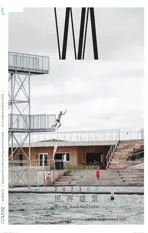上海油罐艺术中心:一个无边界的美术馆,上海,中国
2021-01-26建筑设计OPEN建筑事务所
建筑设计:OPEN建筑事务所
上海油罐艺术中心是全球为数不多的油罐空间改造案例之一。曾服务于上海龙华机场的一组废弃航油罐,经由OPEN建筑事务所6年的改造而重获新生,成为一个综合性的艺术中心。
油罐艺术中心室外是向公众开放的公园,室内则是丰富的展览和活动空间。新建建筑低调地消隐于地景和公园之中,这不仅是对工业遗存的尊重,也是对都市人渴求自然的回应,更是对建立一种新型艺术机构的探索。这是一个无边界的美术馆,人们可以在艺术、自然与城市之间自由穿梭;这也是一个没有完成时的美术馆,空间的灵活性使它可以适应各种需求,不断发展变化。
整个项目谦逊而包容,吸引人们来此亲近自然、感受艺术。美术馆建筑不再是一个“物体”,以高冷的姿态拒人于千里之外,相反,不设围墙的空间随时欢迎任何人的进入和体验,不管是散步、慢跑、遛狗、拍照打卡或是草地野餐。这种设计反过来也激发艺术中心创造出一种全新的运营模式——对外开放以来,除了举办过数场高规格的艺术展览,油罐还成为了艺术节、书展、时装周、人工智能大会等各式各样活动的举办场所,不拘一格、丰富多彩,为周边社区及城市带来蓬勃的生命力。
营造一个可生长的“大地艺术”正是设计的核心。在这件占地将近5hm2的大型作品中,大地是被绿意涂抹的画布,建筑如珠玉点缀其间。5个油罐由覆土绿化的新地形——“超级地面”串联起来。临近公路的1、2号罐相对独立,全部位于超级地面之上;3、4、5号罐则有一半位于超级地面之下,3个罐之间形成开阔的半地下公共空间,包含艺术中心门厅、展览空间、报告厅、咖啡厅和艺术商店等,隔着通透的落地玻璃面向下沉式广场。
从西侧的龙腾大道到东侧的黄浦江边,室外公园的参观路径是多样的,邀请人们自由地漫步其间。如果沿着逐层下降的“阶梯水景”,人们将进入“城市广场”,凉爽的喷雾使得它成为夏季最受欢迎的乐园,而喷雾的平面形态呼应着被拆除的一个油罐。贯穿基地南侧的是一大片“都市森林”,在城市中引入自然的回归;东侧为一片开阔的“草坪广场”,它提供给人们奔跑、休憩的空间,也可以成为室外音乐节等大型活动的观众席。
整个地景中散落着艺术装置,以及两个独立的小建筑,用于举办艺术活动和小型展览。一间被镜面不锈钢包裹的“无影画廊”掩映在都市森林之中,若隐若现;靠近黄浦江边,一座拥有连续锯齿形天窗的“项目空间”则以其鲜明的几何形态与白色的油罐形成强烈反差。
5个油罐的改造策略各不相同。1号罐被规划为两层高的Live-house,置入了一个鼓型的内胆,来围合出一个声学性能适合演出的场所;2号罐被设计为餐厅,内部挖空了一个圆形的庭院,屋顶被改成了可以欣赏江景的平台;3号罐的内部空间几乎被完整保留,为大型的艺术、装置作品提供一个拥有穹顶的展览空间,仅在顶部装有一扇可开启天窗,在需要的时候引入自然光甚至雨水;4号罐内部置入一个立方体并分为3层,成为适合架上作品装挂的相对传统的美术馆;5号罐做了体型上的加法,一个长方体体量穿越罐体而过,形成两个分别面向“城市广场”和“草坪广场”的室外舞台。油罐罐体最大程度保持了工业痕迹和原始的美感,只新增了一些圆形、胶囊形的舷窗和开洞,形成外立面独特的表情,同时给罐内营造了朝向公园和黄浦江的优美框景。
独特的油罐艺术中心定义了新时代的都市艺术机构,它将城市公园与艺术展览、大地景观与建筑空间、工业遗存与创新未来,都天衣无缝地融合起来,并以开放友善、谦逊包容的姿态融入城市生活中,深受公众的喜爱。一个无边界的美术馆发挥着它的无限可能,同时潜移默化地塑造着一种平等、共享的人文精神。

1 首层平面/Ground floor plan
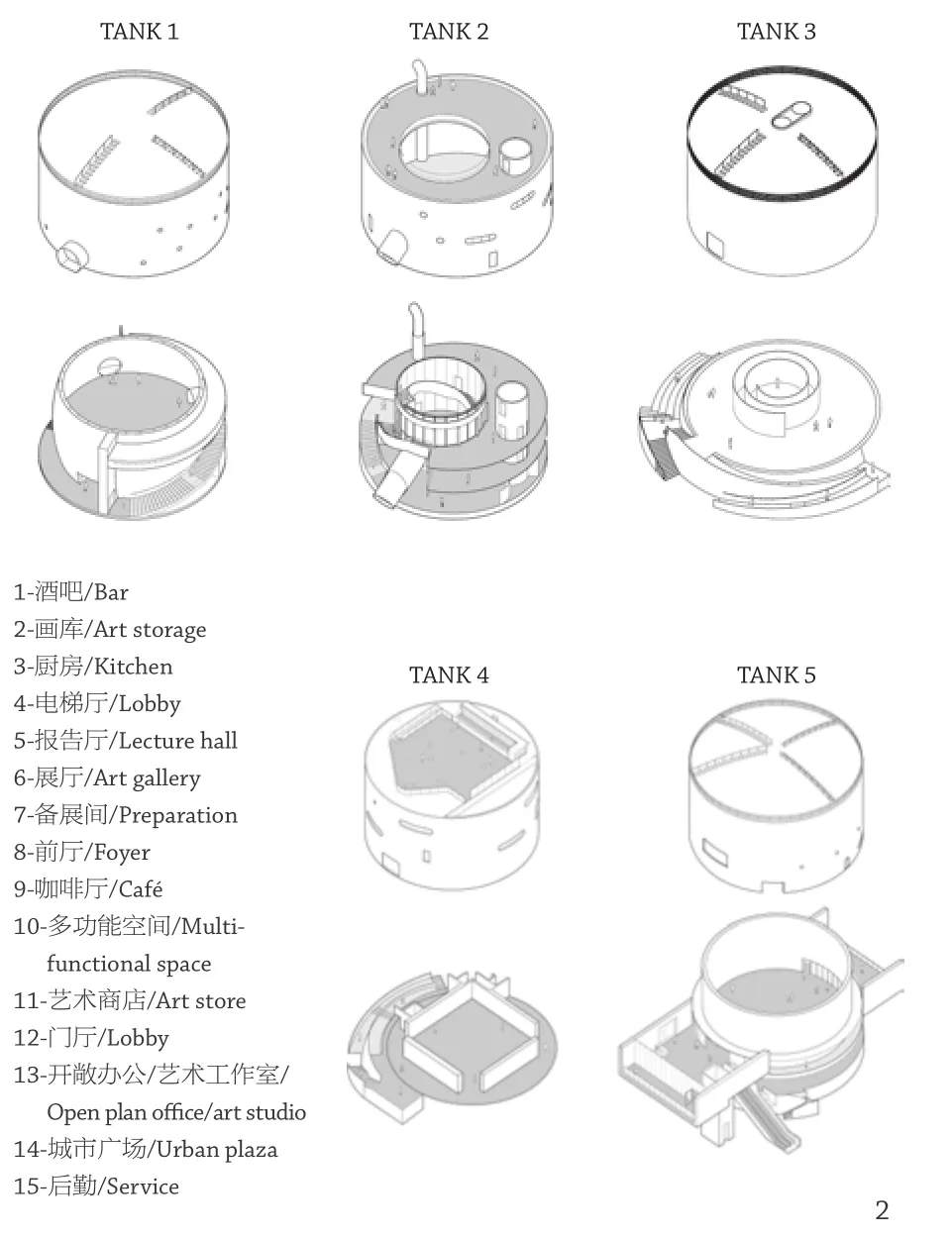
2 油罐轴测/Tank axonometrics
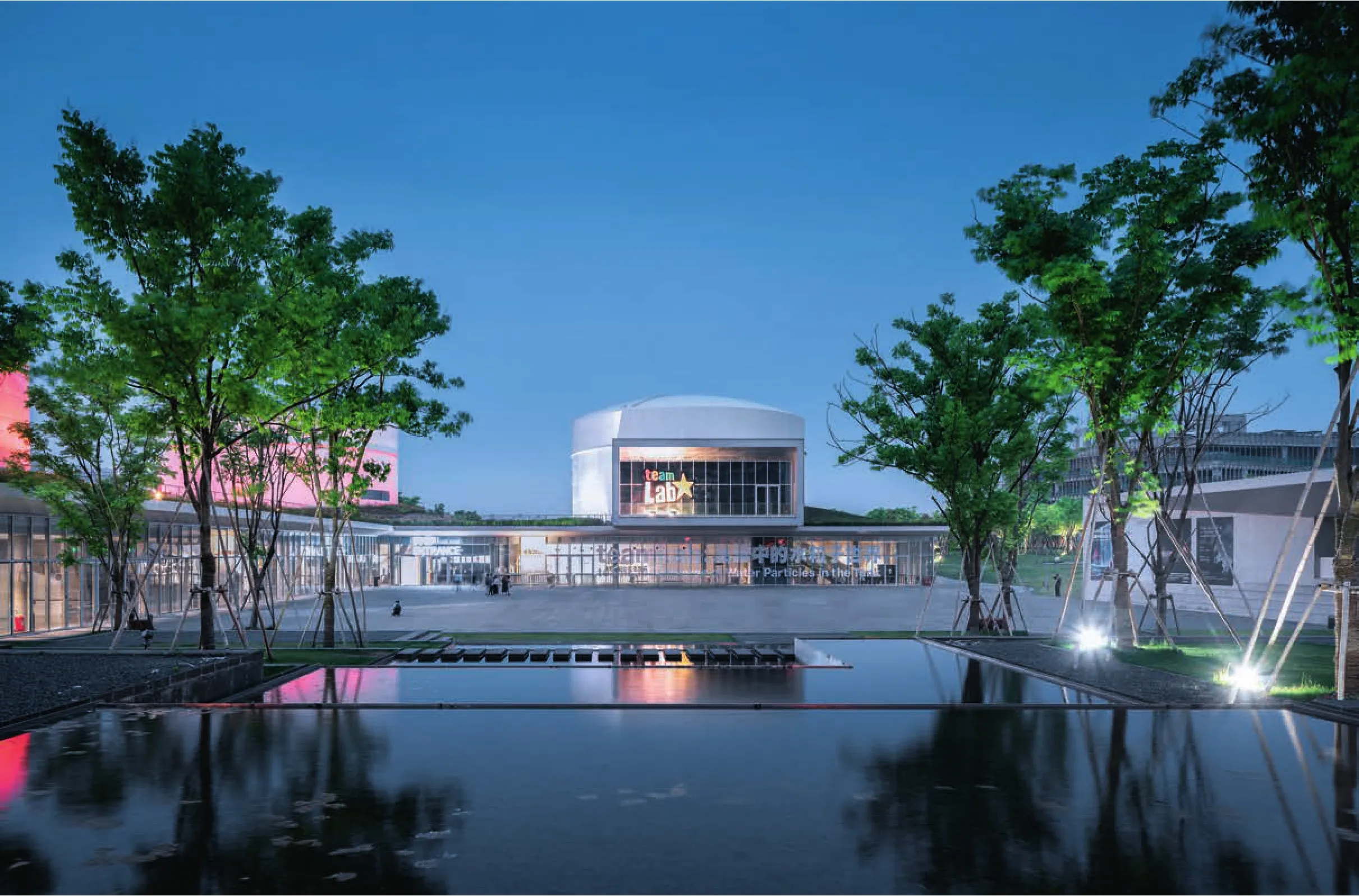
3 阶梯水景/Stepped waterscape
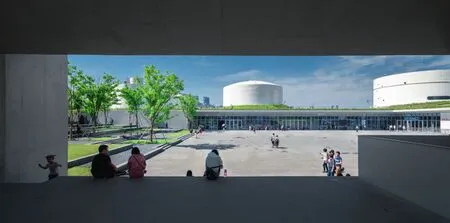
4 城市广场平台/Urban plaza platform
Design Concept
Along the banks of Shanghai's Huangpu River,five decommissioned aviation fuel tanks and the surrounding site - forgotten relics of the city's former Longhua Airport - have been given new life and relevancy. Over the course of six years, these iconic tanks were transformed from fuel containers into a vibrant new art and cultural centre.
Conceived of as both an art centre and an open park simultaneously, the project not only pays tribute to the site's industrial past, but also seeks to dissolve the conventional perceptions of art institutions with formidable walls and definitive boundaries that separate the museum goers from those who are not. It sets out to be an art centre for all, a museum without boundaries.
Long, sloping landscaped meadows down to and around each tank gallery offer open access to the street and riverside, inviting visitors and passersby to move freely between the city, nature,and art. Amidst the backdrop of Shanghai's many more exclusive cultural projects, this gesture creates surprising - and rare - social inclusivity. Many come to the Tanks to view an art show, more come to jog or picnic, or simply to enjoy the undulating landscape with great view of the river. This open approach to the museum space has already brought about unexpected benefits and inspired new operational models for the art centre. Tank Shanghai has hosted not only high-pro file art exhibitions but also many other non-conventional art related events since its opening, such as fashion week, book fair,art festival, and even AI conferences. By attracting vast new audiences, Tank Shanghai has brought unprecedented energy to the formerly desolate industrial neighbourhood.
Central to the project's design is the merging of architecture and landscape through a Z-shaped"Super-Surface" - a 5 hm2landscaped swath of trees and grasses which connects the five tanks and weaves different elements of the site together. Underneath the Super-Surface is the new construction of a large free-flowing open space that connects three of the five tanks from the underground level.
Visitors arriving from the street would descend a pebble path accompanied by a terraced waterscape toward the plaza, and then to the main entry,hardly realising that now they are at underground level. Hidden misting devices create a cooling fog in the centre of the plaza during summer times.At once poetic and practical, this circle of mist was designed to evoke the memory of a sixth tank which was torn down for the construction of the neighbouring heliport, while at the same time improving the microclimate of the Plaza. Flanking the south side of the plaza is an "Urban Forest"which provide much desired greenery and shades to the urban residents. Covering the eastern portion of the site, a second grassy plaza provides open space for outdoor events and leisure, and doubles as a standing room for audiences during music festivals.
The parks and plazas are dotted with a collection of freely accessible public art installations.Dispersed in the surrounding landscape are two separate smaller galleries. Wrapped in mirrored stainless-steel sheets, the Reflecting Gallery re flects the greenery around it and almost dissolves entirely into the Urban Forest. The multipurpose Project Space, overlooking the river and a tree-lined re flecting pool, features a saw-toothed roo fline that deliberately juxtaposes the curvilinearity of the tanks. Across from it, the airport's old firefighting pool now serves as a rectangular reflecting pond surrounded by olive trees.
We approached the design of each of the five tanks in response to the requirements of the different programmes housed within them. Tank 1 - a twostory pub with live music performances - has an added inner volume that is drum-shaped to improve the space's acoustical quality. Tank 2 - a restaurant -is organised around a circular central courtyard, and features a roof deck for alfresco dining. Tank 3 remains almost unchanged except for the addition of a central oculus and fireproofing to meet current life safety requirements. It offers a pantheon - like domed space for large artworks and installations. Tank 4 contains a three-level cube that offers more conventional spaces for gallery and canvas art. Tank 5 features an inserted rectangular volume that passes through the body of the tank and emerges on either side to form two stages on both ends. From the exterior, the surface of all of the tanks preserve their original industrial aesthetics, only occasional capsule-shaped openings and portholes were added to bring light and view to the inside as needed.
Overall, Tank Shanghai represents a new type of urban art institution - one linking the past and the future, fusing art with nature, and more importantly, establishing meaningful connection between people and the place. With its unusual form and mission, we hope Tank Shanghai, the art centre without boundaries, will continue to facilitate and inspire the creation of more inclusive and collective cultural spaces.
项目信息/Credits and Data
地点/Location: 上海市徐汇区龙腾大道2380号/2380 Longteng Avenue, Xuhui District, Shanghai
客户/Client: 上海西岸开发(集团)有限公司 + 上海油罐艺术中心/Shanghai West Bund Development Group + Tank Shanghai
主持建筑师/Principal Architects: 李虎,黄文菁/LI Hu,HUANG Wenjing
设计团队/Design Team: OPEN建筑事务所/OPEN Architecture
项目成员/Project Members: 叶青,罗韧,Victor Quiros,周亭婷,陈修远,李振涛,赵耀,卢笛,贾瀚,张译文,史程昱,周小晨,黄中汉,陈逸岚,崔雨柔,杨骐,戈灿,高琪,Stephanie Lee,金波安,张浩,王莽原,闫迪华,张畅,Tomas Kowalsky,蒋思敏/YE Qing,LUO Ren, Victor Quiros, ZHOU Tingting, CHEN Xiuyuan, LI Zhentao, ZHAO Yao, LU Di, JIA Han, ZHANG Yiwen, Steven Shi, ZHOU Xiaochen, HUANG Zhonghan, Laurence Chan,Cynthia Yurou Cui, YANG Qi, GE Can, GAO Qi, Stephanie Lee, JIN Boan, ZHANG Hao, WANG Mangyuan, YAN Dihua,ZHANG Chang, Tomas Kowalsky, JIANG Simin
合作设计院/Local Design Institute: 同济大学建筑设计研究院/Tongji Architectural Design Group
合作设计院团队/LDI Team: 孙逍阑,张馨培,佘翔(建筑);余金鑫,于发杨(结构);唐振中,武攀,孙晓峰,周东(机电)/SUN Xiaolan, ZHANG Xinpei, SHE Xiang (Architecture); YU Jinxin, YU Fayang (Structure);TANG Zhenzhong, WU Pan, SUN Xiaofeng, ZHOU Dong(MEP)
景观设计/Landscape Design: OPEN建筑事务所 + 北京易地斯埃东方环境景观设计有限公司/OPEN Architecture + Beijing EDSA Orient Planning & Landscape Architecture Co., Ltd.
照明顾问/Lighting Consultant: 上海明驰建筑工程设计有限公司/Shanghai Ming Chi Architecture and Engineering Co., Ltd.
结构体系/Structural System: 钢结构,钢筋混凝土结构/Steel, reinforced concrete
场地面积/Site Area: 47,448 m²
总建筑面积/Total Floor Area: 10,845 m²
设计时间/Design Period: 2013-2019
施工时间/Construction Period: 2017-2019
竣工时间/Completion Time: 2019
绘图/Drawings: OPEN建筑事务所/OPEN Architecture
摄影/Photos: 一勺景观摄影/INSAW Image (fig.3,4,7,8),田方方/TIAN Fangfang (fig.5),OPEN建筑事务所/OPEN Architecture ( fig.6),吴清山/WU Qingshan ( fig.10,11)

5 超级地面/Super-surface
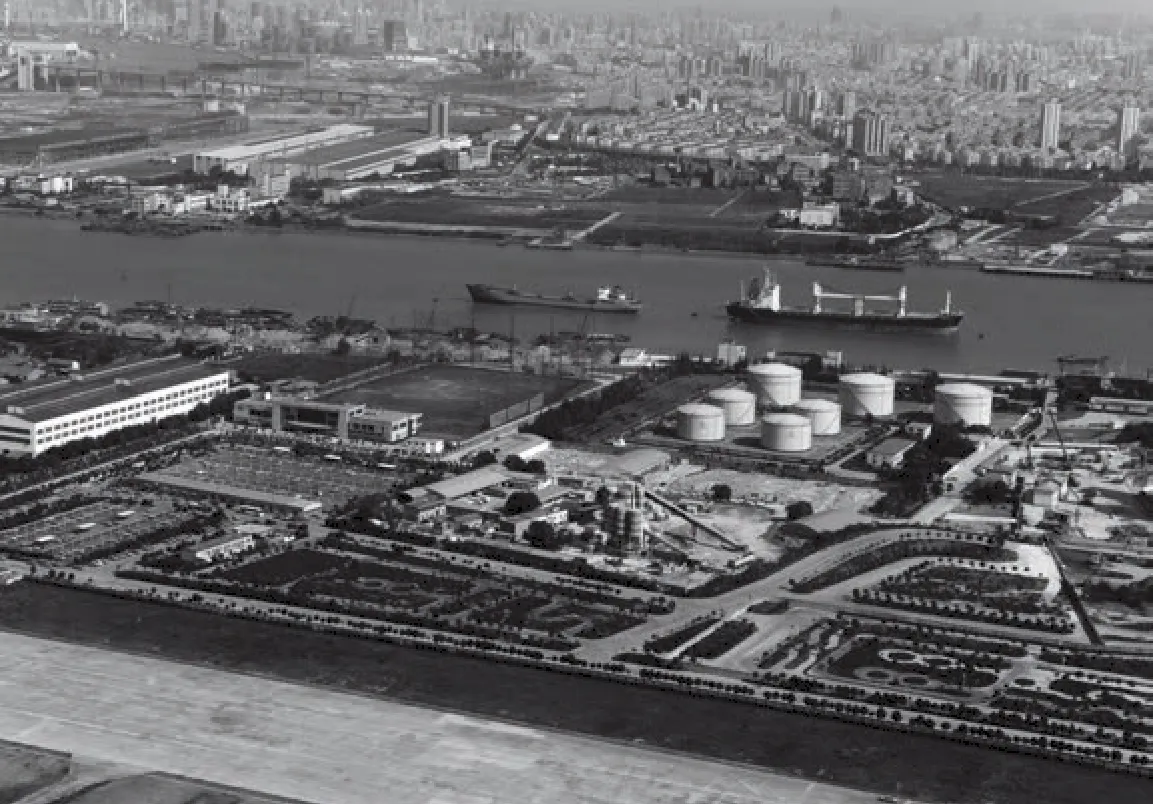
6 改造前的场地/Original site
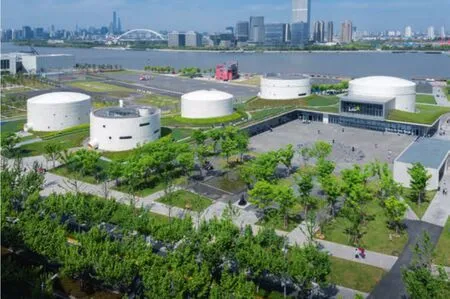
7 鸟瞰/Aerial view
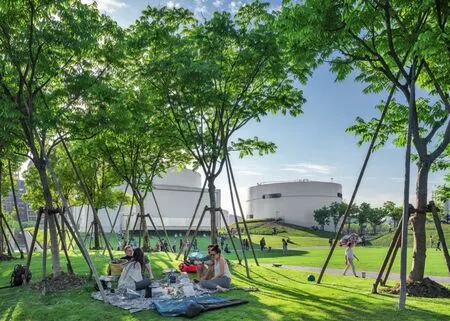
8 都市森林/Urban forest
评委评语
曹嘉明:上海油罐艺术中心出色地利用工业遗存,营造了一个可生长的大地公共艺术作品。巧妙地结合地势,形成了一种开放的、共享的优雅场景。充分利用内部空间设计了不同的功能,使其充满无限的想象力。工业遗存与时代精神的结合,油罐本体与场地的有机结合,场内外空间的流畅以及5个外形一致而功能不同的油罐展览空间,共同构成艺术中心的开放性,使其成为本次评审中最有创意的作品之一。
Jury Statement
CAO Jiaming: The outstanding use of industrial heritage has created a growable earthy public artwork. The smart combination of topography has created an open,shared and elegant landscape. Different functions have been designed to take full use of the interior space, making it in finitely imaginative. The combination of the industrial heritage and the spirit of the times, the organic integration of the tanks with the site, the fluidity of the space inside and outside, five tanks' exhibition spaces with the same shape but different functions, resulting in the openness that makes the Tank Shanghai one of the most innovative works of IUPA 2020.(Translated by PAN Yi)
鲍里斯·沙德-宾索夫:上海油罐艺术中心将上海黄浦江边的5个废弃油罐及其周边工业环境改造为一个艺术中心和休闲公园。该项目把一片废弃区域变成了公共空间。令人印象深刻的是它与周围环境的融合,运用广场、自然元素和道路网络重新赋予地景以活力,并在不同层之间流畅转换。(钱芳 译)
Boris Schade-Bünsow: Tank Shanghai transforms five former fuel tanks and its industrial surroundings on the banks of Shanghai's Huangpu River into an art centre and a leisure park. The project changes the abandoned area into a public space. It impresses with its integration into the surroundings and revitalisation of the landscape with squares, nature, a network of paths and fluent transition between levels.

9 地景组成/Landscape components
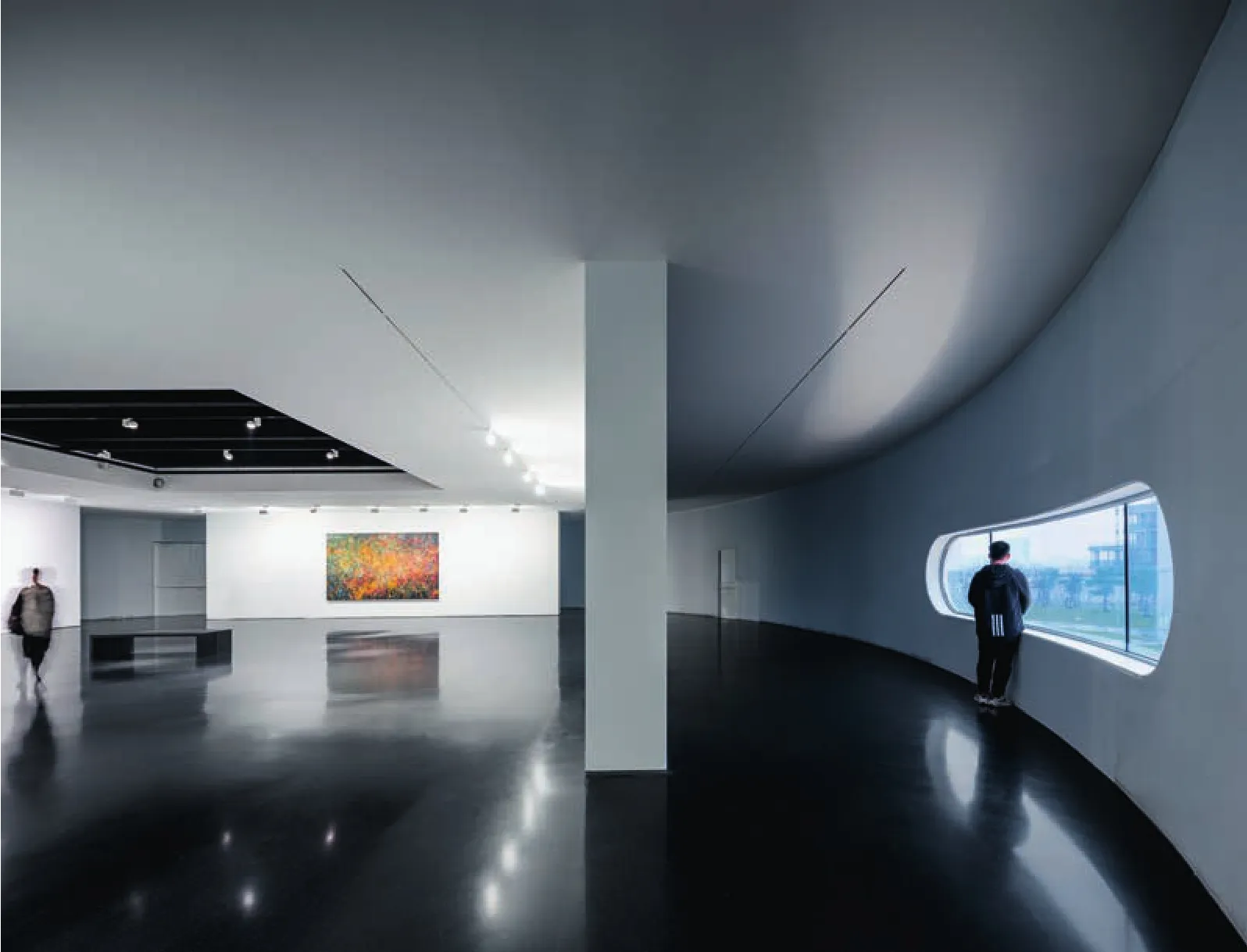
10 4号油罐展览空间/Exhibition space in Tank 4

11 朝向黄浦江的罐体开洞/Opening towards the Huangpu River
